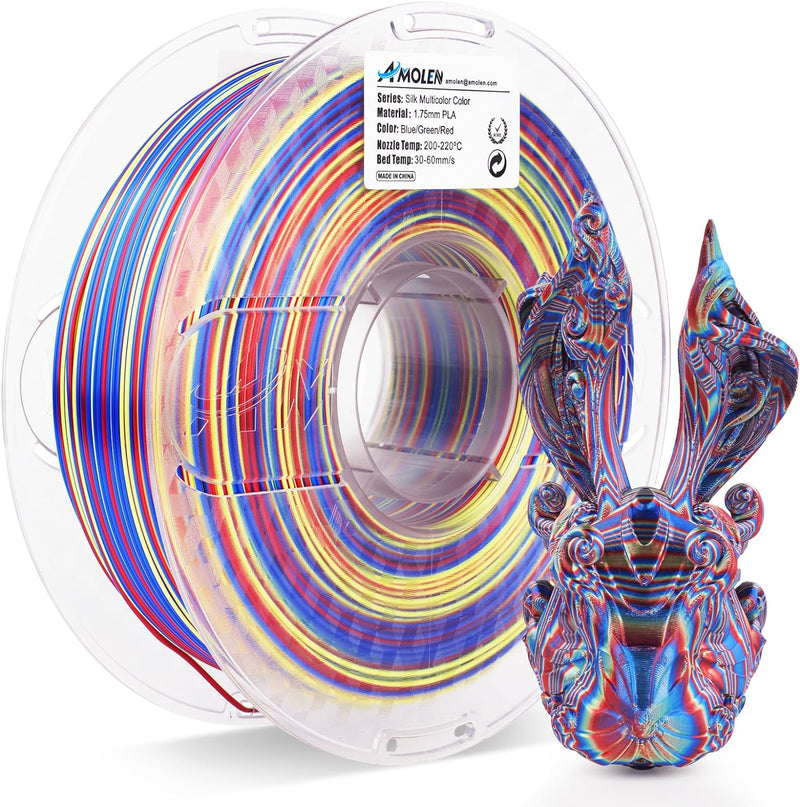Unveiling the Magic of Silk-Finished PLA Filament: Transform Your 3D Prints Today!
In the world of 3D printing, the materials you choose can significantly impact the final product's appearance and functionality. Among the various options available, PLA filament stands out due to its ease of use and eco-friendliness. However, a new trend is taking the 3D printing community by storm: silk-finished PLA filament. This unique material combines the well-loved properties of PLA with a stunning, glossy finish that elevates the aesthetic quality of any printed object. As more hobbyists and professionals delve into the art of 3D printing, the appeal of silk finishes has grown, enhancing not only the visual characteristics of prints but also their perceived value. Whether you’re creating intricate models or eye-catching decorative pieces, silk-finished PLA filament offers an exciting opportunity to transform your 3D prints into true works of art.

Understanding PLA Filament
PLA, or Polylactic Acid, is a biodegradable thermoplastic derived from renewable resources like corn starch or sugarcane. It has become one of the most popular materials in the realm of 3D printing, and for good reason. PLA is known for its ease of printing, low warping, and minimal odor during the printing process. These characteristics make it an excellent choice for both beginners and seasoned professionals. Common applications for PLA include prototypes, models, and everyday items like toys or household objects. Additionally, the material’s biodegradability adds an environmental benefit, appealing to eco-conscious creators. My friend, who recently started 3D printing, found that using PLA allowed him to experiment freely without the frustration of complicated printing processes. His enthusiasm for the material has only grown as he discovered its versatility and reliability.
What is Silk-Finished PLA Filament?
Silk-finished PLA filament is a specialized variant of standard PLA that boasts a uniquely glossy and smooth surface finish. This stunning aesthetic is achieved through a blending process of traditional PLA with additives that enhance its sheen and texture. Unlike regular PLA, which typically has a matte finish, silk-finished PLA reflects light beautifully, giving prints a professional and polished look. The technology behind silk finishes allows for a striking depth of color and a luxurious feel, making it particularly appealing for decorative items or artistic projects. My friend recently printed a decorative vase using silk-finished PLA, and the result was nothing short of breathtaking. The way the light danced off the surface transformed a simple design into an eye-catching centerpiece.
Properties of Silk-Finished PLA Filament
Silk-finished PLA filament inherits many of the desirable properties of standard PLA, including strength, flexibility, and ease of printability. One of its standout features is its impressive strength-to-weight ratio, allowing for durable prints that don’t compromise on quality. Furthermore, silk-finished PLA maintains good layer adhesion, which is essential for achieving smooth finishes and intricate designs. In terms of printability, it performs well at similar temperatures to regular PLA, typically around 200-220°C, making it easy to integrate into existing 3D printing setups. Another significant advantage is its environmental friendliness; being made from renewable resources, silk-finished PLA is also biodegradable, making it a great choice for those looking to minimize their ecological footprint. My friend’s experience with silk-finished PLA showed her that not only could she create striking designs, but she could also do so sustainably.
Applications of Silk-Finished PLA Filament in 3D Printing
The applications of silk-finished PLA filament are vast, making it a versatile choice for a variety of projects. Its visually appealing surface makes it particularly suitable for decorative items, such as sculptures, trophies, and art installations. Additionally, it can be used for prototypes that require an impressive appearance, helping designers showcase their work effectively. Other creative uses include fashion accessories, jewelry, and custom phone cases, where aesthetic qualities significantly enhance the product's value. I’ve seen friends use silk-finished PLA to create stunning cosplay props that not only looked authentic but also felt premium in hand. The finish helped elevate their projects from amateur to professional, garnering attention at conventions and events.
Tips for Printing with Silk-Finished PLA Filament
Printing with silk-finished PLA filament can be an enjoyable experience, especially when armed with the right tips. Firstly, it’s essential to maintain a consistent temperature; most users find that a nozzle temperature of 200-220°C yields the best results. Additionally, a heated bed set to around 60°C can help with adhesion and reduce the chance of warping. To achieve that signature smooth finish, consider using a slower print speed of about 40-60 mm/s, allowing for better layer definition. Post-processing can also play a crucial role; lightly sanding the surface can enhance the shine, while a clear coat spray can provide added protection and luster. One of my friends used these techniques while printing a decorative lamp, and the final product was a beautiful blend of functionality and art, showcasing the filament's full potential.
Unlocking the Potential of Silk-Finished PLA Filament
In summary, silk-finished PLA filament represents an exciting advancement in the world of 3D printing, combining the benefits of traditional PLA with a stunning, glossy finish. Its unique properties and aesthetic appeal make it an excellent choice for a wide range of applications, from decorative items to prototypes. By understanding the technology behind this filament and following practical printing tips, creators can unlock the full potential of their 3D prints. Whether you’re a hobbyist or a professional, experimenting with silk-finished PLA filament can elevate your projects, allowing you to create visually stunning pieces that truly stand out. So why not take the plunge and incorporate this magical material into your next 3D printing adventure?







